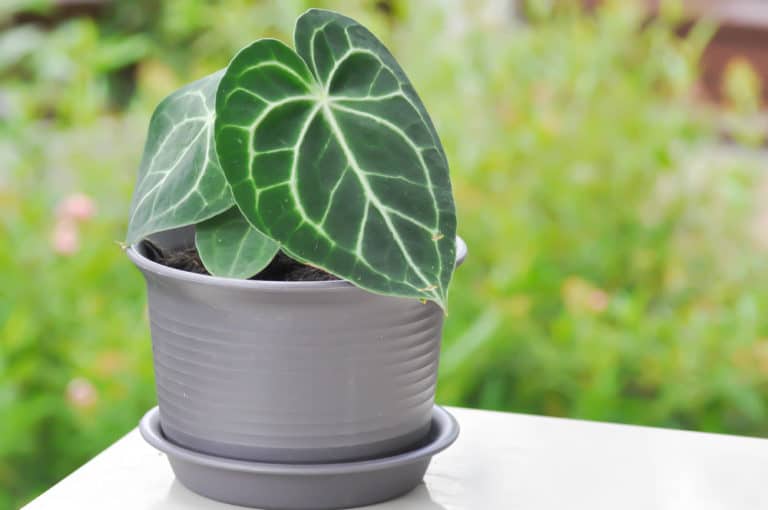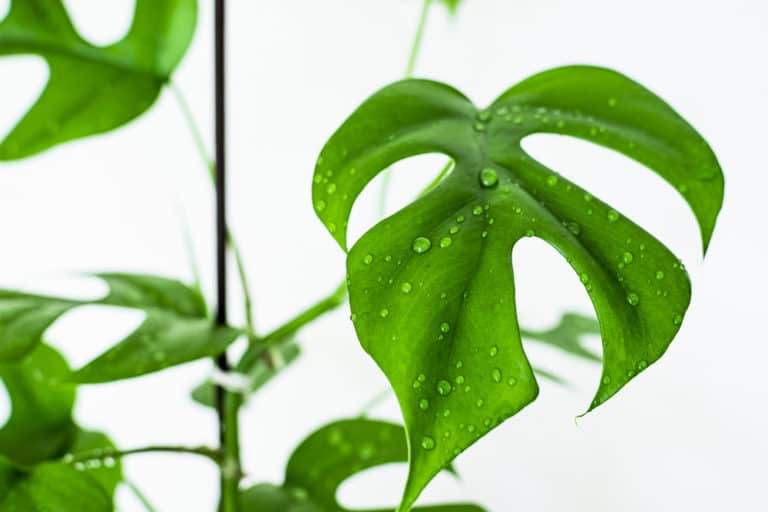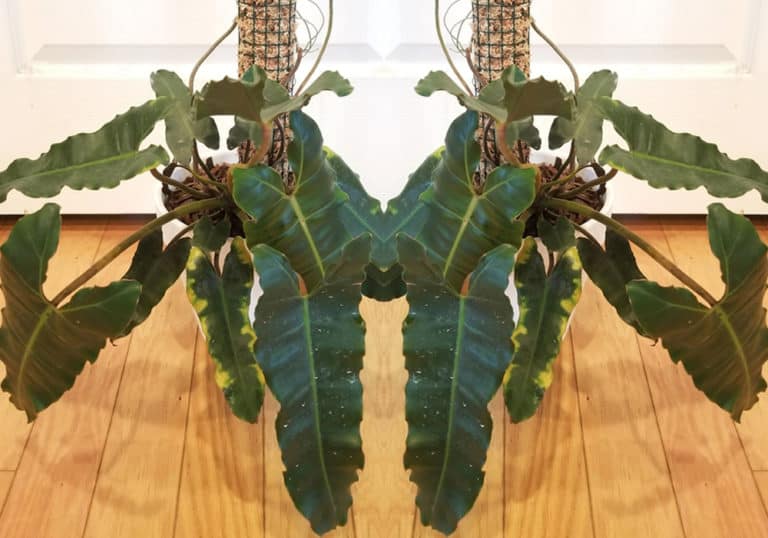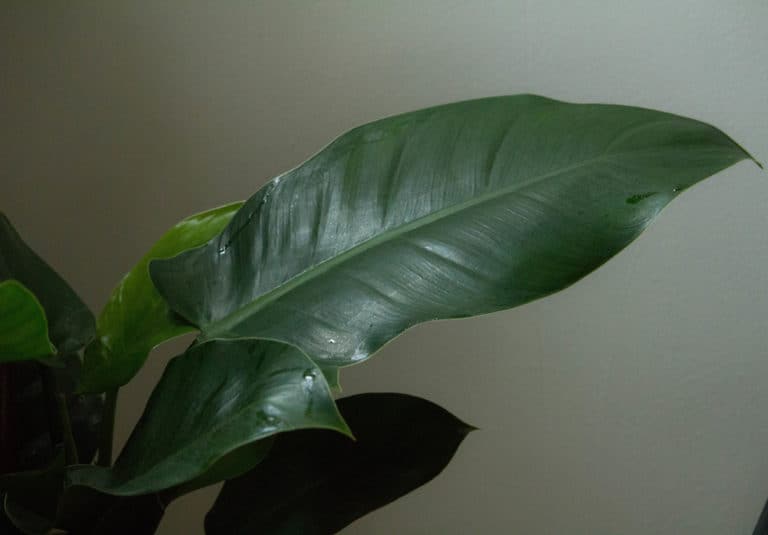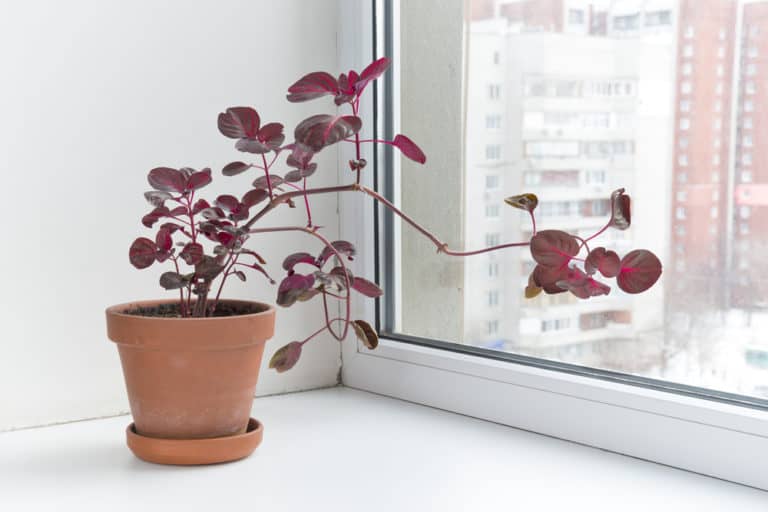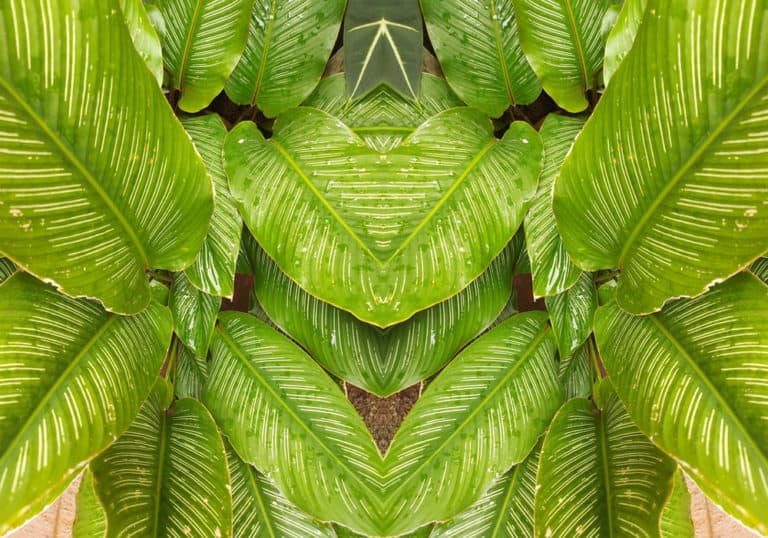Philodendron Erubescens ‘Blushing Philodendron’ Care (2024)

Philodendron erubescens is highly recognized among exotic and beautiful tropical plants. It flaunts a large, waxy set of foliage which do not require full, bright sunlight, hence easy to grow and quick to adapt. The plant thrives indoors all year round but can also be placed outside.
It’s also known as the “blushing philodendron”.
| Scientific Name | Philodendron erubescens |
| Common Name | Blushing Philodendron, Red-leaf Philodendron |
| Light | Bright indirect sunlight |
| Watering | Usually allowed to dry in between watering |
| Temperature | 64 to 77ºF (18 to 25ºC) |
| Hardiness Zone | Zones 10 to 11 |
| Humidity | >50% |
| Soil Type | Rich, quick-draining, loamy |
| Soil pH | Slightly acidic to neutral pH (5.8 – 7.5) |
| Fertilizing | A balanced feed once a or twice a month |
| Repotting | Once the plant has outgrown its current spot |
| Pruning | Beginning of the growing season |
| Propagation | Through stem cuttings |
| Toxicity | Toxic to humans and pets |
| Mature Size | 24 to 36 inches as a houseplant |
| Bloom Time | Late spring, early summer |
What’s Unique About Philodendron erubescens?
Philodendron erubescens plants boast a set of lance-shaped, dark-green leaves that has reddish undersides, almost appearing to have a tinge of wine.
The unique ensemble creates an adorable cascading effect by which the leaves would grow almost downward as it matures. Its name comes from the Latin word Erubescens, which means “to blush”.
Although native to South America, it’s already been widely cultivated worldwide. The plant can grow up to 6 meters high and has a vining habit, providing an interesting touch to dull spaces.
Most philodendrons are known to purify the air. Having them at home is not just aesthetically pleasing but also beneficial!
Philodendron erubescens Care
The Philodendron erubescens plant care is pretty straightforward. For starters, the plant does not need plenty of bright direct sunlight.
They are suitable for almost any growing conditions as long as the other growth requirements are provided.
The discussion below will guide you to the basics of blushing philodendron care.
Light
The Philodendron erubescens light requirements consist of medium to bright indirect light. Given their epiphytic and shade-loving nature, they’re used to growing under canopies of large trees – clinging and wrapping themselves to large trunks as they work their way up. Hence, they are categorized as low light or partial shade plants that need at least 15,000 lux.
Blushing philodendron light needs are easily attained by finding a strategic location, at least 12 feet away from the window. If you wish to grow them indoors, find a spot that receives adequate lighting but not full sun. Avoid direct sunlight as this can scorch their delicate foliages.
Watering
When it comes to Philodendron erubescens watering, it’s important to note that they come from a family that’s quite vulnerable to root rot. It may even be better to underwater than to overdo it.
However, the plant should not be left to dehydrate in between watering either. And so, maintaining a fair moisture level in the soil goes a long way. Make sure to attend to its specific watering needs. Two to three times a week will do.
Pro tip: Water Blushing philodendron once the top inch of the soil feels dry to the touch. Water thoroughly and make sure that no liquid is retained in the pot. So be sure to use containers with sufficient drainage holes.
Temperature
A warm-weather plant, the Philodendron erubescens temperature range is between 60 to 85°F (16 to 29°C). Maintain an optimal temperature indoors of at least 80°F (27°C).
Below 40°F (4.4°C), the plant becomes susceptible to cold injury. Establish them under relatively warm ambient conditions.
It’s crucial to aim for the ideal temperature for blushing philodendron. This will affect the plant’s overall growth. Locations under USDA Hardiness Zones 10 and 11 are great. Philodendrons do well in these places.
While its cold temperature tolerance is low compared to other philodendrons, it still has a lot to offer. It’s versatile for both indoor and outdoor conditions.
Humidity
The Philodendron erubescens’ humidity requirements are influenced by the tropical environment where the plant originates. Thus, to keep the plant happy, place them in highly humid locations.
A humidity level of at least 50 % or higher is perfect. Since most homes have drier air, you may place the plant in areas with adequate moisture in the air, such as bathrooms and kitchens.
Techniques to achieve the ideal humidity for blushing philodendron involve regular misting, using a humidifier, and imposing the pebble tray method. Do the latter by setting up a tray filled with pebbles. Fill it with water until the pebbles are almost covered. Then, place the plant above it.
Soil
The optimum Philodendron erubescens soil mix is one that’s organically rich, well-draining, and loamy. That’s because you want to make sure that the plant medium can hold adequate moisture – but not too much that it becomes soggy.
When it comes to pH level for blushing Philodendron, start from slightly acidic to neutral. This pH should not be less than 5.8 and certainly not more than 7.5.
Pro tip: For your soil mix, combine sphagnum peat moss, vermiculite, or perlite. This will not only enrich your soil for blushing Philodendron but will also improve the overall structure of the soil.
Fertilizer
In order to cope with the plant’s fast-growing quality, you need to give the Philodendron erubescens fertilizer once or twice a month. While inadequate fertilizer is rarely an issue, you may be able to notice some slow growth and even chlorosis or yellowing of the leaves. This is definitely not a pleasant sight for any plant parent.
Giving your Philodendron erubescens plant some TLC will certainly reward you with a healthy vibrant specimen! A balanced fertilizer ratio of 15-15-15 or 10-10-10 diluted to half strength ensures optimum growth.
To avoid fertilizer burn, apply fertilizer for blushing philodendron in a regulated manner.
Potting & Repotting
Growing Philodendron erubescens may require you to repot from time to time. Starting from a small-sized pot when they’re young to a relatively larger one to accommodate their growth.
Worry not because potting or repotting blushing Philodendron is quite easy. Use a medium that’s peat-based, and add with perlite or orchid substrate.
Choose a pot size two to four inches larger in diameter with sufficient drainage holes. When their size has doubled from their initial proportion, you should place a pole to provide support.
Philodendron erubescens’ repotting is typically done in Spring. As the plant matures, you may not have to repot as often.
Pruning
Philodendron erubescens can grow up to 20 feet high. Hence, regular pruning will help maintain their shape and structure. Cutting blushing Philodendron’s spent leaves will also prevent the onset of diseases.
A little trim here and there goes a long way. It keeps your plants healthy and flourishing.
Philodendron erubescens pruning techniques involve cutting or pinching growth just above a leaf node, as this is the point where the new leaf or stem will ensue. Always use a sterile and sharp pruning shear when you cut spent leaves, flowers, or tips of vines. Prune diseased or insect degraded portions as well to prevent further infection.
Propagation
Philodendron erubescens’ propagation through cuttings is relatively easy. Mature plants eventually sprout aerial roots on their leaf nodes. This forms another root system that may establish on surfaces and later on sustain itself.
When you choose to propagate blushing philodendron through cuttings, choose a portion with multiple aerial roots. Use sterile pruning shears. The cutting should be at least 4 – 7 inches long.
Fill a pot (6×6 inches) with the fresh potting mix. Add some water to moisten the soil. The cuttings should have 3-4 leaves located a few inches from the bottom. Place the plant in a warm, humid spot under indirect light. Roots take form within 3-4 weeks.
Also, make sure to check out our in-depth Philodendron Florida ghost care guide.
Common Problems of Philodendron erubescens
One problem you might encounter is the number of leaves that may become too overwhelming after a period of time. The plant may not be able to support itself so there’s a need for a trellis. Regular pruning also proves to be beneficial to prevent other problems with blushing Philodendron.
Pests and diseases also count as Philodendron erubescens problems.
Pests
Most common Philodendron erubescens pests are aphids and scales. The plant may initially exhibit some resistance. If left untreated, it creates bigger problems for your blushing philodendron.
Aphids are soft-bodied insects that feed on plant sap. They can build high population densities and damage plants by removing nutrients. It can result in withering and even death. Honeydew excrements from aphids also encourage the proliferation of sooty molds that impairs photosynthesis.
Early detection leads to early treatment. Remove aphids and scale bugs by hand or by pruning infected plant parts. Use natural insect sprays and keep the infested plant away from other plants until pest problems and diseases subside. Horticultural oil also does wonders.
Diseases
One of the most common diseases that may infect your Philodendron blush is bacterial leaf spots. The former is characterized by reddish-brown watery spots that rapidly spread on the leaf surface. The latter’s symptoms are dark-brown spots with yellow halos on leaf edges.
Blushing philodendrons are quite adaptable. However, you should not ignore their susceptibility to certain diseases. Be on the lookout for pest that feeds on the foliage, creating wounds. These become entry points for pathogens.
A stress-free environment keeps these infections at bay. Cultural management such as proper watering, use of sterile equipment, and providing sufficient nutrients will help prevent the occurrence of Philodendron erubescens diseases.
Growing Problems
Early signs of growing problems manifest on the leaves. They either grow smaller than usual or in contrast become too long or sparse. Factors attributed to such symptoms are incorrect lighting conditions, under or overwatering, and an inappropriate growing medium.
When caring for an indoor philodendron plant, aim for an environment almost similar to that of their tropical habitat. Also, be mindful of the physical aspect of tending to these plants, such as spacing, container size, and airflow.
A sick plant is no good, so maintain its vibrance by fertilizing them as needed. Prune regularly, water adequately, and maintain the optimum temperature and humidity.
Toxicity of Philodendron erubescens
Blushing philodendron is toxic to people and animals when ingested. It’s crucial that they are out of reach of small children and pets. If planted outdoors, make sure that no livestock can get close to the plant, such as cattle, goats, and chickens. Read further for an overview of their toxicity to humans and animals.
For Humans
All plant parts of the Philodendron erubescens contain needle-like calcium oxalate crystals. If ingested by humans, it can cause immediate pain, burning sensation, and swelling of the lips, mouth, tongue, and throat.
If any contact with the mouth happened, wash your hands thoroughly and seek direct help from a physician. Be sure to explain in full detail the nature of your symptoms in order to get the right treatment for a potential poisoning and a severe allergic reaction.
Small children are at risk when bringing your philodendron inside your home. So, choose an elevated location such as windowsill and countertops. Whenever you are tending to the plant, wash your hands afterward.
For Pets
Philodendron blushing plants are no doubt toxic to your furry friends. Calcium oxalate is a toxic element that can cause a lot of discomfort to your dogs and cats. If consumed, animals may experience oral pain and irritation as well as blisters in their mouth. Some symptoms are excessive drooling, swelling of the lips and tongue, difficulty in swallowing, and vomiting.
Any of these symptoms will require a visit to the vet doctor. Call the animal poisoning hotline. Do this to determine ways how to help your pets relieve their pain as you prepare to bring them into the animal clinic.
Philodendron erubescens Appearance
The alluring Philodendron erubescens’ appearance points to the plant’s fresh and delightfully dark-green foliage – which are glossy and in the shape of an arrowhead or elongated heart. The flowers, on the other hand, are characterized as deep red fragrant spathes that spread to about 15 cm. The plant takes a vining form and grows up to 20 feet.
Foliage
Philodendron erubescens are remarkably embodied by a glossy set of dark-green heart-shaped foliage. Leaf color may range from coppery, red to purplish-green. This depends on the amount of light received by the plant as well as the current development stage.
Juvenile leaves are almost always burgundy while mature leaves are dark green with red undersides. The venation of the leaves is usually green, others may have white or red veins.
Apparently, the foliage of Philodendron erubescens has a trailing habit and has tiny hairs that give their leaves an almost iridescent coloration. Exposure to a medium to bright indirect light enhances the vibrance and color pattern of each leaf.
Flowering
The Philodendron eurbescens’ flowering occurs for as long as 15 to 16 years. It signals that the plant reached the sexual maturity stage. This phenomenon showcases deep red flowers during spring and summer. If grown indoors, the plant would typically bloom in Autumn.
The blushing philodendron flower has a complex structure: a spathe, which is a leaf-like enclosing hood, and the spadix, which is a tubular structure within the spathe. The spadix features male and female flowers, usually having off-white to yellowish colors.
Each plant has 2 to 3 blooms that open throughout the blooming period of two days. To encourage reproduction, you can pollinate by hand. Rub the pollen on the female part of the spadix.
Size and Growth
As a houseplant, the size of Philodendron erubescens ranges from 24 to 36 inches in height. Yet, the plant can still grow up to 20 ft. tall and at least 4-6 ft. wide. In their natural habitat, the plant can even span out to a staggering 60 ft. tall. This depends on how good the growing conditions are.
It has a relatively fast growth rate, with up to 4 inches a week, particularly during spring and summer. To grow your plants bigger, place them on a spot that receives an ample amount of bright, indirect sunlight. Also, feeding the plant more often with a balanced nutrient facilitates more vigorous growth.
Philodendron erubescens Fragrance
The Philodendron erubescens fragrance is attributed to its blooms that feature sweet-smelling spathes. Each plant usually has two to three flowers that open at different times throughout the blooming period. Nighttime is when the blooms have the strongest fragrance.
The smell of flowers is a known evolutionary scheme to attract pollinators. Flowering plants have a stronger scent at night to attract nocturnal pollinators as well, such as moths.
Should you be worried about their smell when you grow them indoors? Note that Philodendrons generally have no smell as a foliage plant. The flowers have, but the blooming period takes years.
Suggested Uses for Philodendron erubescens
Philodendrons are no doubt one of the most popular ornamental plants being grown indoors. The plant is known to purify and improve air quality by removing pollutants such as formaldehyde. Plus, their fresh and vibrant foliage induces a sense of calmness and tranquility.
As an interior plant, they’re often used by landscape architects as massive silhouettes against walls surrounding a garden. As a houseplant, you can place them on a windowsill or on top of a display table to have that nice tropical touch. This will certainly brighten up any dull spaces at home. Add to that, Philodendron erubescens are quite easy to tend to.
Philodendron erubescens Varieties
The many varieties of the Philodendron species results from massive domestication, breeding techniques, and natural or induced mutation in order to achieve different variegations and coloration.
The particular characteristics of the Philodendron erubescens are large waxy leaves with a tinge of red and long aerial roots. The common name, blushing philodendron, is attributed to the plant’s dazzling pinkish appearance.
While there have been many Philodendron erubescens varieties, the uniqueness among these variants is still evident in terms of the quality of leaves such as shapes, sizes, and color patterns. Listed below are some of the equally gorgeous types of blushing philodendron.
Philodendron ‘Pink Princess’
The Philodendron Pink Princess is a stunning plant specimen. It has splendidly pink and large waxy deep-green leaves that can grow up to 9-10 inches long and 5-6 inches wide.
Philodendron erubescens ‘Ruby’
The Philodendron erubescens ‘Ruby’ differs from other variations because of the burgundy stem that holds the dark green leaves with red undersides. This plant can reach impressive heights so they need ample space.
Philodendron erubescens ‘Imperial Red’
The Philodendron ‘Imperial Red’ has lush foliage. The leaves are oval in shape having a leathery texture. Characterized as having a bushy growth, it needs a fair level of humidity to thrive.
Philodendron erubescens ‘Red Emerald’
The Philodendron ‘Red Emerald’ is an aroid that has red-colored stems. The leaves and the petiole are also red when young, but eventually, turn dark green and shiny upon maturity.
Philodendron erubescens ‘Green Emerald’
The Philodendron ‘Green Emerald’ flaunts a set of bright-green foliage which has a glossy appearance. This climbing houseplant has spade-shaped leaves that are perfect for indoor gardens or simply as a corner plant specimen.
Philodendron erubescens ‘Gold’
The Philodendron erubescens ‘Gold’ is an evergreen climber having red stems and heart-shaped leaves. The flowers have deep red color and a fragrant smell. This philodendron loves the filtered sun and can grow up to 36 inches.
FAQ
What is Philodendron erubescens?
Philodendron erubescens, also known as blushing philodendron is a flowering species belonging to the plant family, Araceae. Extensively grown for their stunning foliage and intricate growth habit.
How to identify Philodendron erubescens?
Philodendron erubescens is characterized as an aggressive climber with leaf blades that grow from 9-to 18 inches in length. It features shiny green leaves with a reddish-purple underside.
How to care for Philodendron erubescens?
They love to flourish under bright, indirect light. Use a well-draining soil mix with a slightly acidic to neutral pH and maintain a temperature of 16-29 °C and humidity at >50 %.
How to grow Philodendron erubescens indoors?
Grow them indoors under filtered bright light. Use an aroid soil mix and maintain a temperature of 18-29 °C. Maintain higher levels of humidity and water only as needed.
How to grow Philodendron erubescens outdoors?
You can grow them outside year-round under a shady spot where they receive just enough amount of light. Keep the soil consistently moist, but not too soggy. Prune and repot as needed.
How fast does Philodendron erubescens grow?
The plant can grow up to 4 inches a week, particularly during spring and summer. Once the growing season arrives, the vines can grow up to 10 cm per week!
How tall does Philodendron erubescens grow?
As a houseplant, the Philodendron erubescens can grow at about 24-36 inches in height. However, it can reach a towering height of 20-60 feet when left in its native environment.
How to make Philodendron erubescens grow faster?
Feeding your Philodendron with a balanced fertilizer or an NPK ratio of 10-10-10 reduced to half strength once or twice a month would encourage faster growth.
How to stake Philodendron erubescens?
Plant a stake deep into the soil alongside the plant that needs support. Be sure to drive the stake all the way to the bottom of the container.
How to pot Philodendron erubescens?
Gently remove the plant from its old spot and place it on a larger pot. Use fresh garden soil mixed in with peat moss and perlite.
How to revive Philodendron erubescens?
Revamp your plant by placing them on a spot that receives ample indirect light. If you notice signs of a disease, remove the infected parts.
Why is my Philodendron erubescens dying?
Check out the stress signs for your Philodenderon erubescens. You may be overwatering, underwatering, or the humidity level is too low. Monitor your temperature regime and provide the plant with adequate nutrients.
Why is my Philodendron erubescens drooping?
The most likely cause of drooping leaves is overwatering or underwatering. Pay attention to the growing medium if it’s draining well. Water only as needed.
How cold can Philodendron erubescens tolerate?
Philodendron erubescens are not a frost-hardy plant. They will thrive at a temperature range of 55 to 80°F (13 to 21°C), but certainly not below 50°F (13°C).
How to get rid of pests on Philodendron erubescens?
Easily get rid of pests by rubbing alcohol or by spraying both the upper leaf surface as well as the undersides. Use natural insecticides such as neem oil and citronella oil.
Is Philodendron erubescens toxic to cats?
Yes. Philodendron erubescens are moderately toxic to cats and dogs. It contains calcium oxalate crystal that when ingested may cause adverse reactions such as swelling of the mouth.
Is Philodendron erubescens toxic to dogs?
Yes, Philodendron is poisonous to dogs. When a significant amount has been ingested, they could experience severe respiratory and digestive issues which will need immediate attention from a vet.
Is Philodendron erubescens toxic to children?
The Purple heart-leaf philodendron is toxic to small children. Ingestion of the plant can lead to a dermatitis reaction, and swelling of the mouth and digestive tract.
Is Philodendron erubescens toxic to humans?
In humans, the Philodendron erubescens usually has a mild effect causing allergic reactions and dermatitis. However, severe symptoms can occur such as inflammation of the mouth and digestive tract.
Does Philodendron erubescens have a scent?
Philondendron erubescens generally do not have a scent unless it’s the blooming period. During nighttime, the flowers have the strongest sweet scent. Pheromones are also produced to attract pollinators.

